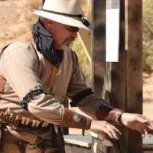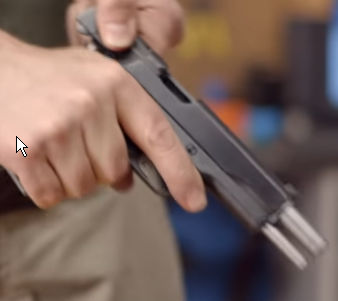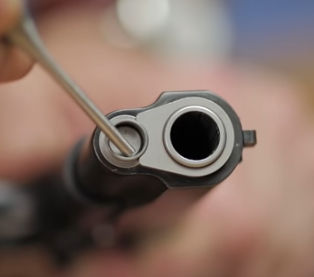-
Posts
907 -
Joined
-
Last visited
-
Days Won
150
Content Type
Profiles
Forums
Events
Everything posted by Garrison Joe
-

One powder to rule them all?
Garrison Joe replied to C.N. Double's topic in Reloading for Wild Bunch
I have used WST in all the cartridges you listed, including .38 special. IMHO, It's absolutely the finest target powder in .45 auto and 12 gauge. It's OK in .45 Colt (and Cowboy .45 Special). Have never tried it in a BAMM load, and never will (too fast for anything but plinker loads in mil rifles). Clays or Clay Dot will also run right with it. As mentioned, Red Dot also. And those two/three will be slightly cheaper to load. Good luck, GJ -
And here's why it is easy to spot a full length guide rod without making the shooter disassemble the gun:
-
Yes, solid full length guide rods have to stick through a hole in the replacement cap that comes with it (otherwise, the slide would not have room to open backwards toward the grip frame). Here's a snapshot from muzzle showing tip of rod inside of the cap. You can see a video showing installation and operation at: Courtesy of Brownell's Tech Department.
-
JB - Yep.
-

Are Model 12 stocks "long"?
Garrison Joe replied to Three Foot Johnson's topic in The Wild Bunch Wire
That stock was HEAVILY sanded by someone who did not understand the importance of protecting the wood profile during a stock refinish. It lost a little strength, but probably not enough to lead to immediate stock damage. Good luck, GJ -

Are Model 12 stocks "long"?
Garrison Joe replied to Three Foot Johnson's topic in The Wild Bunch Wire
M12 buttstocks are not normally longer than 14" LOP. Of course, adding a thick rubber recoil pad to a stock originally made for a thin hard butt plate (if not cut down appropriately) easily adds 3/4" to LOP. Yours in that picture does not quite have the lines of a factory stock, so I would guess it's a replacement to obtain the long LOP. Good luck, GJ -
You're right, here's another good explanation from Shotgun World forum:
-
Couple of common reasons, both bad news: Someone lengthened the chamber (or installed a 3" chambered barrel) Gun is heavily worn and chamber has been blown out so that now 3" shells chamber. I got one with a blown chamber, and had it sleeved by a gunsmith who has now passed on. Is his ejection port large enough to cleanly pass 3" fired shells? Sometimes "gunsmiths" "fixed" that also if they lengthened the chamber. Good luck, GJ
-
A factory installed vent rib is legal on a model 12. A factory installed Cutts or Lyman External Choke/Compensator is not (but were installed on a fair number of guns by the factory). Must be 12 gauge. 16, 20, 28 gauge (and .410 versions called the Model 42) not allowed. A Model 25 is not legal. It is VERY similar to a Model 12, but has a shorter magazine tube. Be careful about getting a real 12. Model 12s were made by Winchester until about 1964. A later model usually will have more life left in it than one made in the 1910s. Original parts are pretty available for Model 12s. Now, the devil's advocate position: One of the recently made Win 97 clone shotguns is very fast and reliable, and a lot more cowboy gunsmiths are familiar with fixing them than a Model 12. I have seen more Model 12 guns bind up when run real fast than I do a well maintained 97. And, of course, the 97 was designed by JMB. The 12 was not. But, it's your money. Good luck, GJ
-
I can tell you what we just shot at 2019 EOT. Because I organized this on short notice while at the match. We had three heavy AR500 targets that are angled at 45 degrees from vertical, and several competitors had brought jacketed ammo, so we once again shot BAMM on one of the cowboy bays. Three 16" diameter targets were set at 70-75 yards, with about five feet separating them. Either jacketed (including FMJ) or lead bullets were allowed. The stage was shot as follows: A timed bench rest or shooting sticks pass with five rounds. Followed by an "unsupported" position pass with five rounds. Positions permitted were standing, sitting or kneeling, with use of a military sling allowed if desired. Each pass was timed separately, then the raw times, misses, penalties from both passes were added to give a total time. Pass 1: Benchrest from sandbags, or from a range-provided simple benchrest stand, or using elbow support from bench, or from shooter-provided shooting sticks. Action open, 5 rounds loaded in magazine, and on beep, fire a Nevada sweep starting from an end target for five rounds. Pass 2: Commercial rifle shooting mat provided for shooters to use during this pass. Shooter allowed to assume their desired shooting position with rifle held in hands, action open, NO rounds loaded in magazine. On beep, load rifle magazine and shoot the two outside targets of the array, alternating between them for five rounds. Only one shooter asked about shooting from prone position. That was not allowed because a large fraction of our competitor group would have a hard time using that position. This changed up a little the previous scenario used at EOT, which has usually been 10 rounds all from a rest. Had 19 competitors, and we awarded the first, second and third place finishers among men and among women. Finished in about an hour and a half.
-
Confirmed - NO ONE shot Wild Bunch at EOT clean. The standing joke of reading the "clean shooters" list first - which consists of a short silence, was repeated once again at Founders this June, too.
-
Good question! This mistake is called "Overloaded Rounds That Are Fired" rather than illegally acquired ammo. Page 26 of the Shooter's Handbook lays the penalty out pretty clearly: So, IMHO, the call (by the rule book) should have been P plus two extra rounds that hit target #4 (2 five-second penalties) is P plus 10 seconds. Even though the #4 target had been hit already four times with appropriate shots. Now, this does seem rather overly-penalized, I agree. If shooter had MISSED #4 target with two shots at the end of the string, having already hit #4 four times, rules would call for NO penalty "overloaded ammo hit target" penalty seconds, just the Procedural penalty. Good luck, GJ
-
You have to know your sight settings to hit 16" targets (or larger) from 80 to 280 yards. That will cover all the available shooting ranges at EOT. I thought I remembered just shooting BAMM on Bay 16 last year, at about 90 yards. Good luck, GJ
-

Need Model 12 gunsmith recommendation ...
Garrison Joe replied to Dead Head's topic in The Wild Bunch Wire
Do you mean that the bolt went forward, and the shell was not raised high enough by the carrier for the bolt to catch the rim of the shell and shove it into the chamber? Or do you mean the cartridge jams into the back of barrel and stops the bolt from going forward? If shell was properly on carrier, then carrier is not rising far enough to get the shell ready to chamber. If shell was not fully on carrier (nose still in mag tube), then it's hanging up in the magazine tube/cartridge cutoff. Is the failure to feed more common when tilting the 12 to the right? If so, tilt it to the left, because you either don't have a flag or the flag is not operating well. Good luck, GJ -

Need Model 12 gunsmith recommendation ...
Garrison Joe replied to Dead Head's topic in The Wild Bunch Wire
One of the best general gunsmith shops for the Model 12 is NuLine Guns, of Rhineland, MO. They may not know exactly what Wild Bunch is, but they certainly know how a Model 12 works. Have used them to rebuild a very worn Model 12. http://www.nulineguns.com Good luck, GJ -
I've fixed all my Chinese 97s simply by cutting the magazine spring so that it's uncompressed length is about 3 inches longer than the magazine tube. Haven't had to swap followers or use any of the 6-shell kits. If you want to cut a spring that is not the factory provided one, get a mag spring for a Remington 870 in 12 gauge. Pretty cheap item. Good luck, GJ
-
Win Super Target. WST
-

Clearing Long Guns on the Line
Garrison Joe replied to Abe E.S. Corpus's topic in Wild Bunch Rules Forum
Have seen several guns dropped or handled without a lot of care after being cleared at Winter Range and even EOT. NONE were ever made a penalty call. If there was careless gun handling involved (not just a dropped gun or a fallen cart), then usually the shooter was sternly warned to be more careful with gun handling, and if they repeated the careless handling, an "Unsafe gun handling" SDQ would be issued. I don't find any of the WB (or even Cowboy) rules that penalize a sweep of another person with an unloaded gun while off the firing line to allow any other penalty than Unsafe Gun Handling. Good luck, GJ -

Short Stroke Kits for the 73 in WB
Garrison Joe replied to Joe Burr's topic in Wild Bunch Rules Forum
Well, Pioneer folks are usually very willing to discuss the legality of their kits - you can call them. Both of their kits I am familiar with are legal length of stroke. You need to seek out pards who are quite a bit more knowledgeable of WB rules. A short stroke for rifle follows same restrictions as on the Cowboy side. Yes, I have the Pioneer standard short stoke kit in one of my 73s. Quite legal and nicely built. Good luck, GJ -
On par with Rock Island - yes All the others you listed - no. Good luck, GJ
-
WB Minor Safeties and Procedurals are time adjustments, having same value as in Cowboy scoring: MSV = 10 seconds added to raw time for each one called on stage Procedural = 10 seconds added to raw time for the first one on a stage Raw time + Miss penalty time + (MSV and Procedural) penalty time => Total time BTW If we are taking a vote, I too would suggest that published scores at WB matches always have a "detailed score" version made easily available. My other vote is that I generally like stage point scoring, as on every stage you are scored against the "fastest shooter" on that stage. Good luck, GJ
-

Shotshells less than 2.75”
Garrison Joe replied to Abe E.S. Corpus's topic in Wild Bunch Rules Forum
When the first 1897 shotguns were made, they WERE CHAMBERED for a shorter shell. 2 9/16." A short shotgun shell is an historically correct way to shoot Wild Bunch! -

Shotshells less than 2.75”
Garrison Joe replied to Abe E.S. Corpus's topic in Wild Bunch Rules Forum
Generally, short shells are legal. The 2.5" shells from B&P are often used to let unmodified shotguns start with six rounds loaded, because that is a common stage description maximum limit, and that gets shooters "even" with folks who have modified the mag springs or followers to let them load six. Generally, it's best if stage instructions are clear and are written as if a shooter might be using shorter shells. So, don't say load to "initial target sequence" if that would give some shooters an advantage. Make the description support the concept of a level playing field, with all shooters starting with same number of shells. Say, "may load up to six shells." Good luck, GJ -

45acp load recommendation for my wife
Garrison Joe replied to Leadfoot Luke's topic in Reloading for Wild Bunch
Load your RN (or RNFP) bullet correctly so you don't leave part of the driving band sticking out above the mouth of the case. Only the rounded (ogive) section of the bullet nose should be above the case mouth. Then taper crimp to a finished OD of about 0.472" right at the case mouth. Then GAUGE in a loaded ammo gauge (or in a pinch, in your barrel taken out of gun) so every round fits in the chamber. If you have any that don't, correct your die settings (and components) until you have perfect feeding and chambering ammo. Chrono your loads before going to any major match, too, so you (she) won't get a surprise with a load that fails to make 150 PF as an absolute minimum. Best to load for about 162 PF as a safety margin. Since our ammo power factors are lower than what the factories usually spring the 1911 for, this does give you the opportunity to make the 1911 easier to rack the slide, if your wife would like that. For our 160 PF loads, the mainspring (inside the mainspring housing at back side of lower grip frame) can be lightened to about 17 or 19 pounds (from the factory 23 pounds), the recoil spring can be lightened to 15 (or even 14) pounds, and the firing pin stop can be rounded on the bottom edge (or a replacement purchased with a rounded bottom edge), all of which make the 1911 less challenging for some women to rack the slide, which we have to do at least twice a stage. If that pistol is still going to carried for "serious purposes" and practice fired a lot with factory loads, though, you may just wish to leave the factory springs in it. As for a powder that is temperature stable, I'd recommend Clay Dot from Alliant. WST is pretty good at being temperature stable, too, but it is slightly weaker when HOT weather sets in - the reverse profile for temperature sensitivity from most other powders, which are cold-weak. If you are running loads that are Wild Bunch compliant, you WILL NOT have anywhere as much problem with cold weather as much weaker SASS cowboy loads often do. Good luck, GJ -
OK, you've described the action of the cutoff as if gun is upside down. Directions on a firearm should be written as if gun is upright and held ready to fire. The cutoff only is active during the part of the cycle where the lifter is raising the first shell up to the chamber. While lifter is doing that, the cutoff tip RISES so it sticks out onto the base of the (second) shell in the mag. Otherwise, during the rest of the firing cycle, the tip of the lifter holds shells (mostly) inside the mag tube. The amount of movement of the cutoff tip on a fairly new (1950s) M12 of mine from fully down (with action closed) to fully up (blocking the shell) is 0.120" If you don't get half that much movement, the engagement nub on the bottom side of the cutoff where cutoff is pushed down by action slide lock arm opening is worn or damaged, or the nub on the back end of the cutoff is worn, thus preventing enough force being applied to pivot the cutoff. Find a buddy with a M12, compare how the tip of the cutoff is shaped, to your part. If sufficiently worn or bent, a cutoff fails to hold shells in mag tube, intermittently. If the tip looks good, then check the back-end nub of the cutoff that pivots the cutoff - that area may be bent or worn. Installing a new cutoff may be fastest way to check this. Nu-Line Guns in Missouri has cutoff's for M12 12 gauge: http://www.nulineguns.com/part_part_70_3_31_42.php As does Midwest Gun Works https://www.midwestgunworks.com/winchester-model-12/parts.html Both are $40. Good luck, GJ


